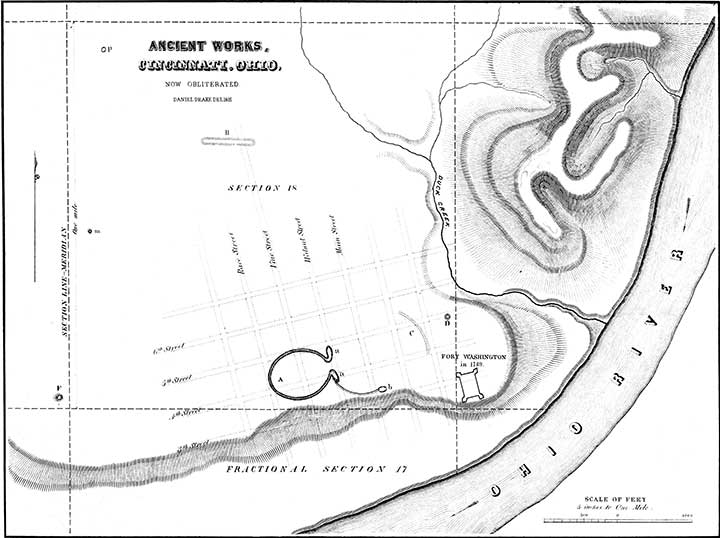PLATE IV.
ANCIENT WORKS AT CINCINNATI (NOW OBLITERATED).

Figure A is nearly elliptical, the major axis being eight hundred and thirty, and the minor seven hundred and thirty feet; the height of bank two feet; the breadth of base thirty. The entrance on the east is ninety feet wide, guarded by two low oblong mounds, a, a. From the entrance, to b, is a low wall, or high road, one foot high, and nine broad, and b is a mound eight feet high, sixty feet broad, and one hundred and twenty feet long. When, in the progress of city improvement, this mound was removed, a large number of trinkets were found at its base. D is a circular bank, one foot high, fifteen feet broad, and sixty feet in diameter.
C appears to be a portion of an unfinished, or obliterated work, which must have been large, perhaps including the works at A. At B is an enclosure, the parallel sides of which are forty to forty-six feet asunder, seven hundred and sixty feet long, about two feet high, with an opening on the south, thirty feet wide.
F represents an oblong mound, thirty-five feet high, which, until 1843, was not entirely obliterated. General Wayne, whose army encamped near it in 1793, cut off the summit, in order to erect a sentry-box. It was in this mound that the curious carved stone was found, which is described by Squier and Davis, in the first volume of Contributions, page 275. P is an excavation, two feet deep, and fifty feet across; and m is a mound nine feet high. The high ridges to the east of Duck Creek are about four hundred feet above low water, and composed of the "Blue Limestone," a member of the Silurian system.
The first bench is within range of high water, that is, sixty-one feet above extreme low water. The second bench is composed of gravel, with strips of sand, into which wells have been sunk at the work. A, ninety feet, to the level of the river, before procuring water.
The plateau rises towards the rear to one hundred and twenty-seven feet, at the foot of the mountains, a mile and a quarter from the river.
It is remarkable that the mound-builders of old, and the city builders of our own times, selected in a great many cases the same sites. Portsmouth, Marietta, Circleville, Chillicothe, Alexandersville, Frankfort, Piketon, and Newark, are on or near the sites of the ancient cities.
Among many mounds and embankments, this people have left very few excavations; thus indicating a want of metallic implements, of the size and kind necessary to remove solid earth. This is likewise manifest, from the fact that no quarries of rock have been discovered which can be referred to their labors. The mounds and walls of stone which they have left, are formed of loose and small stones, such as a man, or at most two men, could lift, and thrown together loosely, without being trimmed or cut.

